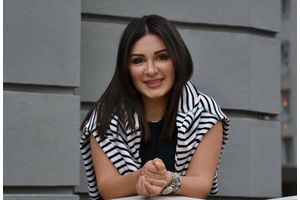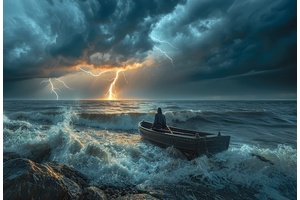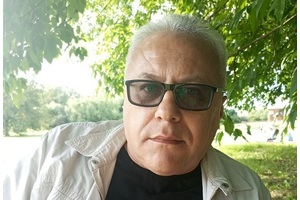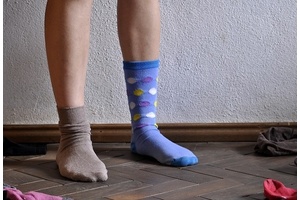High Gothic is in essence a proto-Renaissance, and stylistically - the beginning of Classicism. Many heads and figures of the work of the masters of the Rheims school directly repeat the ancient ones: "a man with the head of Odysseus", "a smiling angel", statues of Mary and Elizabeth (on the right side of the central portal of the cathedral in Reims). In late Gothic, this tendency is intensified. Separating from the wall, pylon or beam of supports, the statue is freely positioned in front of the wall, and then in a niche; gaining independence, sculpture enters into a new interaction with architecture. E. Con-Wiener wrote that “in the Angels of High Gothic, the feminine subtlety of the head reaches grace, to sophistication, a graceful smile plays on thinly outlined lips, hair is tied with a bandage, and beautiful curls form a hairstyle, the closest resemblance of which we can find in women of Attica the times of Phidias. " In the Gothic statues of the XIV-XV centuries. a special bend appears, a soft, plastic line, called the "Gothic curve". It is associated with the ancient Greek chiasm, but differs in atectonicity and destructiveness. The "Gothic curve", like the immaterial light painting of stained-glass windows, is nothing more than a denial of the ancient principle of corporeality. The form of a Gothic statue dissolves in the plasticity of draperies, folds, fractures, as if lifted by a metaphysical whirlwind. These folds, like the movement of the figure itself, are not constructively motivated, which is why they sometimes seem strangely playful, mannered, inappropriate to the seriousness of the situation. This strangeness is explained not by dilettantism - the sculptor's ignorance of the rules of plastic anatomy, but by a special attitude. E. Con-Wiener interestingly notes that the Gothic era was distinguished by unprecedented "freedom of the body", "the liberation of movement in all directions." This is evidenced by, somewhat strange in our opinion, images of women with implausibly curved backs and protruding bellies, clearly made as a model of beauty. “The style of life itself, in all likelihood, became more agitated, the blood began to circulate faster in the veins of the people than in the Romanesque era. The Crusades, the songs of the troubadours and the philosophy of that time tell us about this ... Gothic makes women weep over the tomb of the Savior, Angels rejoice - in a word, it brings emotion, excitement ... All the wealth of biblical and legendary themes begins to serve as a program to decorate the church and the book , the whole ecclesiastical world outlook with its abstract ideas finds its expression in stone and colors. "
https://all-andorra.com/category/blog/the-cities-of-the-pyrenees/
https://all-andorra.com/la-baule-escoublac/
https://all-andorra.com/saint-nazaire/
https://all-andorra.com/guerande/
https://all-andorra.com/cognac-city/
https://all-andorra.com/place-in-the-sun/
https://all-andorra.com/pornichet/
https://all-andorra.com/saintes-city/
https://all-andorra.com/soulac-sur-mer/
https://all-andorra.com/jard-sur-mer/
https://all-andorra.com/noirmoutier-en-lile-and-the-most-expensive-potatoes-in-the-world/
https://all-andorra.com/bordeaux/
https://all-andorra.com/les-sables-dolonne/
https://all-andorra.com/pornic/
https://all-andorra.com/saint-gilles-croix-de-vie/
https://all-andorra.com/bretignolles-sur-mer-and-its-famous-protest-vendee-pro-wqs-4-stage-for-professional-surfers-of-the-world-championship/
https://all-andorra.com/saint-jean-de-monts/
https://all-andorra.com/pons/
https://all-andorra.com/perigueux/
https://all-andorra.com/le-croisic/
https://all-andorra.com/fouras-city/
https://all-andorra.com/angouleme-french-capital-of-cartoons-and-comics/
https://all-andorra.com/le-chateau-doleron/
https://all-andorra.com/le-pouliguen/
https://all-andorra.com/niort-city/
https://all-andorra.com/chatelaillon-plage/
https://all-andorra.com/thouars-and-its-sights/
https://all-andorra.com/ronce-les-bains/
https://all-andorra.com/saumur/
https://all-andorra.com/eauze-capital-of-armagnac/
https://all-andorra.com/saint-palais-sur-mer/
https://all-andorra.com/royan/
https://all-andorra.com/rochefort-city/
https://all-andorra.com/la-rochelle/
https://all-andorra.com/nantes/
https://all-andorra.com/eze/
https://all-andorra.com/cannes/
https://all-andorra.com/saint-tropez/
https://all-andorra.com/toulon/
https://all-andorra.com/saint-raphael/
https://all-andorra.com/monaco/
https://all-andorra.com/villefranche-sur-mer/
https://all-andorra.com/antibes/
https://all-andorra.com/beaulieu-sur-mer/
https://all-andorra.com/avignon/
https://all-andorra.com/sainte-maxime/
https://all-andorra.com/marseille/
https://all-andorra.com/cagnes-sur-mer/
https://all-andorra.com/cavalaire-sur-mer/
https://all-andorra.com/montpellier/
https://all-andorra.com/travel-websites/
https://all-andorra.com/sete/
https://all-andorra.com/beziers/
https://all-andorra.com/meze/
https://all-andorra.com/frejus/
https://all-andorra.com/menton-city/
https://all-andorra.com/aix-en-provence-city/
https://all-andorra.com/nimes/
https://all-andorra.com/terrassa/
https://all-andorra.com/sabadell/
https://all-andorra.com/mataro/
https://all-andorra.com/mandelieu-la-napoule/
https://all-andorra.com/san-sebastian/
https://all-andorra.com/bilbao-city/
https://all-andorra.com/dax/
https://all-andorra.com/bayonne/
https://all-andorra.com/pau/
https://all-andorra.com/biarritz/
https://all-andorra.com/lourdes/
https://all-andorra.com/tarascon-sur-ariege/
https://all-andorra.com/limoux/
https://all-andorra.com/pezenas/
https://all-andorra.com/agde/
https://all-andorra.com/carcassonne/
https://all-andorra.com/talamanca-city/
https://all-andorra.com/rennes-le-chateau/
https://all-andorra.com/quillan/
https://all-andorra.com/toulouse/
https://all-andorra.com/castelnaudary/
https://all-andorra.com/perpignan/
https://all-andorra.com/vilanova-i-la-geltru-city/
https://all-andorra.com/arboc-city/
https://all-andorra.com/prades/
https://all-andorra.com/alet-les-bains-nostradamus/
https://all-andorra.com/castelnou/
https://all-andorra.com/villefranche-de-conflen/
https://all-andorra.com/narbonne/
https://all-andorra.com/lloret-de-mar-sights-and-beaches/
https://all-andorra.com/vieux-boucau-les-bains/
https://all-andorra.com/corca-and-its-sights/
https://all-andorra.com/tossa-de-mar-sea-resort/
https://all-andorra.com/montblanc/
https://all-andorra.com/figueres/
https://all-andorra.com/pals/
https://all-andorra.com/vernet-les-bains/
https://all-andorra.com/begur/
https://all-andorra.com/verges/
https://all-andorra.com/girona/
https://all-andorra.com/sant-llorenc-de-morunys/
https://all-andorra.com/lerida-lleida/
https://all-andorra.com/cervera/
https://all-andorra.com/els-prats-de-rei/
https://all-andorra.com/berga/
https://all-andorra.com/solsona/
https://all-andorra.com/catalan-cities-tarrega/
https://all-andorra.com/balaguer/
https://all-andorra.com/escaldes-engordany/
https://all-andorra.com/cardona/
https://all-andorra.com/the-city-of-ax-les-thermes-the-skiing-spa-center-of-ariege-department-french-pyrenees/
https://all-andorra.com/foix-the-most-touristy-city-of-ariege-france/
https://all-andorra.com/tremp/
https://all-andorra.com/the-cradle-of-catalonia-ripoll-and-its-tourist-attractions/
https://all-andorra.com/catalan-city-of-puigcerda/
https://all-andorra.com/manresa/
https://all-andorra.com/argeles-sur-mer-and-its-beaches/
https://all-andorra.com/rennes-les-bains/
https://all-andorra.com/suria/
https://all-andorra.com/campan/
https://all-andorra.com/torroella-de-montgri/
https://all-andorra.com/the-city-of-saint-lizier/
https://all-andorra.com/vic/
https://all-andorra.com/sitges-the-most-elite-seaside-resort-in-the-costa-dorada-catalonia/
https://all-andorra.com/calafell-the-best-seaside-resort-in-catalonia-for-holidays-with-children/
https://all-andorra.com/reus-antonio-gaudi/
https://all-andorra.com/salou-costa-dorada/
Medieval art, especially Gothic art as its highest, classical expression is imbued with sensuality, expression and incredible tangibility of the Mysteries. In the chapel of the Holy Cross of the Karlstein castle near Prague (1348-1365), according to the conclusion of the researcher of medieval architecture S. Boissere, a description of the mystical church of the Holy Grail found a "miniature embodiment". Emperor Charles IV (1346-1378) ordered to veneer the chapel walls with polished agates, amethysts and other stones mentioned in the Apocalypse, in the description of the “New Jerusalem”. According to legend, the huge Cologne Cathedral was founded in 1248 by the famous theologian and alchemist Albert the Great (1206-1280) in order to place in its altar the remains of the "Three Holy Kings" - Caspar, Melchior and Belshazzar - the three wise men who brought gifts to Bethlehem on Christmas night. The holy relics of the "kings" were brought to Cologne in 1164 by order of the Emperor Frederick I Barbarossa from Milan, where they were then. The history of the founding of the cathedral is thus interpreted as a recognition of the wisdom of the East, which influenced the young Christian culture of the West. The tangible, materialized symbolism of the late Middle Ages was revealed in lavish festivities, street processions and performances. The surviving descriptions of such holidays are striking with bizarre imagination and colorfulness. In 1389, in Paris, during the solemn entry into the city of Isabella of Brabant from the tower of the Cathedral of Notre Dame, "an Angel descended with the help of skillful weapons", crowning the queen with a crown. Naked maidens splashed in the waters of the river, depicting sea sirens ... From the mouth of an artificial dragon, struck by Hercules, live birds flew out ...
https://all-andorra.com/tarragona-history-tourism-and-what-to-do/
https://all-andorra.com/orthez/
https://all-andorra.com/saint-jean-de-luz/
https://all-andorra.com/ciboure/
https://all-andorra.com/the-holidays-of-the-french-school-of-andorra-the-summer-trip-to-france-port-leucate/
https://all-andorra.com/port-vendres/
https://all-andorra.com/hostalric/
https://all-andorra.com/lestartit/
https://all-andorra.com/osor-city-in-the-municipality-of-the-region-of-la-selva/
https://all-andorra.com/the-city-of-valls/
https://all-andorra.com/pas-de-la-casa/
https://all-andorra.com/font-romeu-france/
https://all-andorra.com/encamp/
https://all-andorra.com/sort/
https://all-andorra.com/la-seu-d-urgell-spain-catalonia/
https://all-andorra.com/collioure/
https://all-andorra.com/os-de-civis/
https://all-andorra.com/capital-andorra-la-vella/
https://all-andorra.com/san-julia-de-loria/
https://all-andorra.com/ordino/
https://all-andorra.com/canillo/
The masts of ships with multi-colored pennants were completely covered with sheet gold. Excitement reigned in life, people shed tears over trifling reasons and most of all they loved to watch the death penalty. Impressiveness, stormy experiences, a passionate desire to meet a miracle led to the creation of art forms that correspond to the Gothic style. Color played a special role in this. Contrary to popular beliefs about the "gloomy Middle Ages", Gothic is bright and colorful. Polychrome painting of walls and sculptures, colored glass of stained-glass windows in the interiors of cathedrals were complemented by variegated tapestries hung in the arcades of the naves, fresh flowers, the glitter of gold of church utensils, the glow of candles and bright clothes of the townspeople filling the cathedral. Common everyday costumes combined white, orange, green, red and yellow colors (they were also repeated in the painting of wooden statues in altar compositions). The color blue was considered a symbol of loyalty; yellow - especially beautiful, and green meant falling in love - green was more often worn by women. It is often said that "the color of Gothic is purple". This is the color of prayer and mystical aspirations of the soul - a combination of the red color of blood and the blue of the sky. Medieval stained glass windows are indeed dominated by red, blue and purple colors. In subsequent eras, when rational thinking began to dominate, purple harmonies were little used. However, in addition to this, color had a special formative meaning in medieval art, since painting and sculpture had not yet separated from architecture. Somewhat later, in the Renaissance, with the advent of easel painting, painting took over the function of color, and then buildings and statues became more monochrome. (Something similar happened in ancient art, and, in the reverse order - the reunification of color, construction and plastics - was observed in the Modern period, at the turn of the XIX-XX centuries.) ”, Assimilation of forms - repetition of the same elements (sometimes one in another) on different scales. This phenomenon is called "romance of scale" in Gothic art. Countless towers and turrets of Milan Cathedral, as if reflected one into the other, cease to be reality, turn into imaginary, into images of each other. In such a composition, familiar landmarks, scale disappear, and a person is not able to navigate in distances and sizes - a fantastic, surreal space appears. The composition of the Gothic temple is almost exactly repeated in the reliquaries, which are called architectonic. Previously, in Romanesque art, these were just caskets, boxes, boxes, now - a cathedral in miniature. The carved wooden furniture is likewise likened to the temple model.











